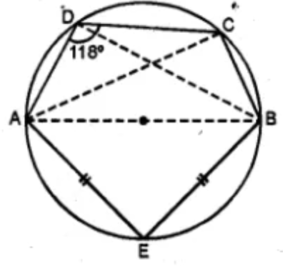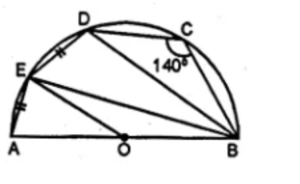
(B) inthe figure given below, AB is the diameter of the semi-circle ABCDE with centre O. If AE = ED and ∠BCD = 140°, find ∠AED and ∠EBD. Also Prove that OE is parallel to BD.

Solution:
(a) Join DB, CA and CB. ∠ADC = 118° (given) and ∠ADB = 90°
(Angles in a semi-circle)
∠BDC = ∠ADC – ∠ADB
= 1180 – 90o = 28o
∠ABCD is a cyclic quadrilateral)
∠ADC + ∠ABC = 180o
118o + ∠ABC = 180o
∠ABC = 180o – 118o = 62o
But in ∆AEB
∠AEB = 90o
(Angles in a semi-circle)
∠EAB = ∠ABE (AE = BE)
∠EAB + ∠ABE = 90o
∠EAB = 90o × ½ = 45o
∠CBE = ∠ABC + ∠ABE
= 62o + 45o = 107o
But AEBD is a cyclic quadrilateral
∠CAE + ∠CBE = 180o
∠CAE + 107o = 180o
∠CAE = 180o – 107o = 73o
(b) AB is the diameter of semi-circle ABCDE
With center O.AE = ED and ∠BCD = 140o
In cyclic quadrilateral EBCD.
(i) ∠BCD + ∠BED = 180o
140o + ∠BED = 180o
∠BED = 180o – 140o = 400
But ∠AED = 90o
(Angles in a semi circle)
∠AED = ∠AEB + ∠BED
= 90o + 40o = 130o
(ii) Now in cyclic quadrilateral AEDB
∠AED + ∠DBA = 180o
130o + ∠DBA =180o
∠BDA = 180o – 130o = 50o
Chord AE = ED (given)
∠DBE = ∠EBA
But ∠DBE + ∠EBA = 50o
DBE + ∠DBE = 50o
2∠DBE = 50o
∠DBE = 25o or ∠EBD = 25o
In ∆OEB,OE = OB
(raddi of the same circle)
∠OEB = ∠EBO = ∠DBE
But these are ultimate angles
OE ∥ BD
